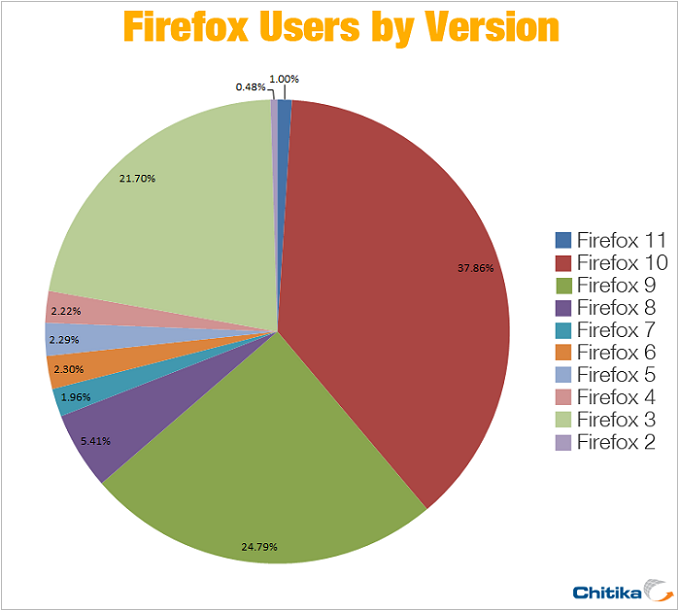In January 2012, Mozilla rolled out Firefox 10, just 6 weeks after introducing Firefox 9. Firefox is known for its rapid-release schedule, and with Firefox 11 set for release later today, there is no sign of slowing down. The most recent version of Firefox is known for its JavaScript and speed, and also marks the launch of Extended Support Release (ESR) for large businesses or organizations. ESR means these organizations can centrally deploy the latest version of Firefox and receive security updates throughout the year, but these updates will not make any changes to the web or any add-ons they may have downloaded.
With the imminent release of Firefox version 11 and 12, a total of 3 version updates will have been released between January and April 2012, and a total of 7 major updates since the start of 2011. Chitika Insights wanted to take a look into the current state of Firefox version fragmentation to get a sense for current levels of adoption among users. Using data comprised of a sample of hundreds of millions of ad impressions from February 2012, Chitika Insights looked at the total web share of Firefox users and then calculated the distribution of impressions for each version Firefox used in this study. The results can be seen below:

According to our data, Firefox 10 currently holds the highest share of Firefox users, with 37.86% of all users operating on the latest version. Firefox 9 trails behind with a 24.79% share of users. Interestingly, Firefox 3 comes in a close third, with 21.70% of the total share of Firefox users still operating on the version first introduced in 2008. We also saw 1% of users on Version 11, which was only available for developers during the time our study was conducted. Firefox 8, which showed a 62.8% share in mid December 2011, now only holds a 5.41% share.
The presence of Firefox 3 is remarkable, as it remains to hold its ground though many of versions have been implemented since 4 came about in 2011. One of the reasons that this may be the case is that Firefox 3 is one of the last versions that does not support an auto-update feature set. Therefore, it may be likely still utilized by those that are not as “tech-savvy” as it was the only version of Firefox available between 2008 and early 2011. This version could also still be in use by businesses or large institutions that seek control over software updates for security purposes. It would be interesting to see how the share of Firefox 3, and other versions of Firefox, may change with the introduction of ESR.
Firefox is also expected to integrate “silent updates” with version 12, scheduled for release in April 2012, which may decrease the widespread fragmentation we see across all versions. However, this may cause controversy for users hoping to retain control of which browser version they prefer to operate on. Despite fragmentation issues, Firefox continues to gain overall market share, with an increase in market share between January and February 2012. Check back with Chitika Insights as we will be tracking adoption rates and version fragmentation for the new Firefox 11 and future updates.
nice post i like
Re: Firefox 3 – some plugins that were available for FF3 are not available for later versions hence some percent of the users stick to version 3